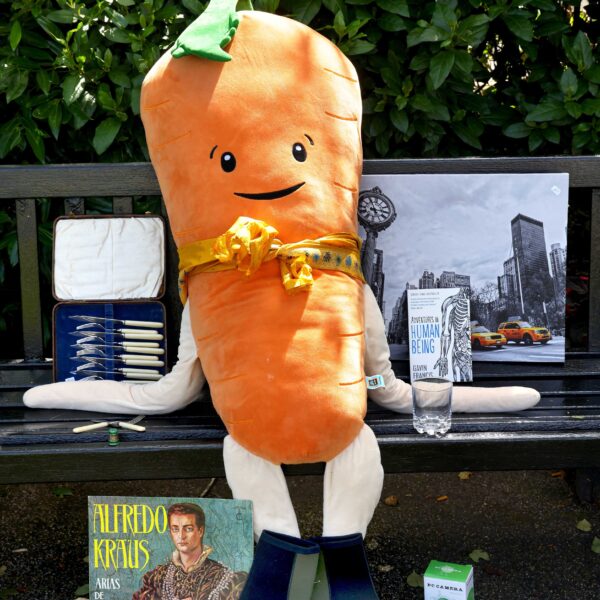Humanity's Future in 10 Charity Shop Objects
Exclusive interview with David Farrier


What will remain of us in a billion years – who are we now and how has today’s way of life come about? David Farrier, author and professor of English literature, dropped into Wigtown’s Community Shop and chose 10 items which he will use at a festival event to help unlock stories of humanity’s past, present and future.
Why the Community Shop?
It’s a great place to find all sorts of things that are being given a new life by recirculating in the community rather than ending up in landfill. One of the things I’ll be talking about is what happens when things do go to landfill, because they don’t just disappear. Many are very durable and have a future that stretches deep into time.
Such as?
I chose a pair of Neoprene wetsuit booties for exactly this reason. Neoprene is an extraordinarily long-lived material, and these days landfill sites are lined with a form of Neoprene as well, which stops anything leaching in or out. So, the booties could survive for many thousands of years. And they would provide an extraordinary amount of information to anyone who dug them up – our technology, the way we lived, our habits.
Why the Aldi carrot, scarf and computer camera?
The carrot was produced by a supermarket. I want to use it to talk about food, about soil and the future of food.
As for the camera, we're accumulating vast amounts of this E waste. We are surrounded by cheaply produced technology that will be used for a short time, then thrown away. That’s because of built-in obsolescence and the way that market forces drive technology.
There’s also a story to be told about what has happened since we started having cameras in our phones. The number of images are captured in the past 10 years is exponentially greater than anything since the invention of photography. There's a climate cost in that. Something like 2%-3% of carbon emissions are generated by the data centres that store our internet traffic and the images we generate.
The scarf takes us the other way, it’s silk and very delicate, but it tells us about the history of materials – stretching back thousands of years – and the development of global trade, first of all through things like the Silk Roads. Globalisation and mass production have transformed human life and had a very profound impact on our world, our biosphere and our civilisation that will stretch far into the future.
And the painting of New York?
There's a big printout of a picture of New York. I chose to talk about the long-term future of our cities. In a million years, what will be left in New York or Shanghai or Tokyo or London?
Land is generally either rising or sinking due to tectonic activity. Often we’re talking about millimetres or centimetres over hundreds of years. But combine that with sea level rise, and you have a perfect recipe for fossilisation.
A city like Shanghai, built on soft ground, is sinking. They've been extracting huge amounts of groundwater in the past hundred or so years. But it's sunk by two and a half metres already, and with seas rising it could eventually fossilise.
Everything on the surface will get eroded away. But subways, skyscrapers with deep roots, subterranean shopping centres, all that will be preserved. So, there's almost a guaranteed prospect that the biggest cities that have ever existed will be legible in the future fossil record a million, 10 million, even 100 million years.
What’s the farthest forward you will be looking?
That’s summed up by the vinyl LP. It’s got Mozart’s Magic Flute on it, one of the pieces of music on the Golden Discs placed on the Voyager I and II spacecraft, launched in 1977, which are heading out to the stars carrying messages from humanity. I chose them, and a book, so we could talk about the future of the arts. What's the future of stories and music?
The Golden Discs are a gesture as they are unlikely ever to be discovered. But they mean that in deep time, billions of years from now, when everything else is gone – including the Earth itself – there will still be the music of Mozart, along with natural sounds like the songs of birds and whales, travelling out there in space.